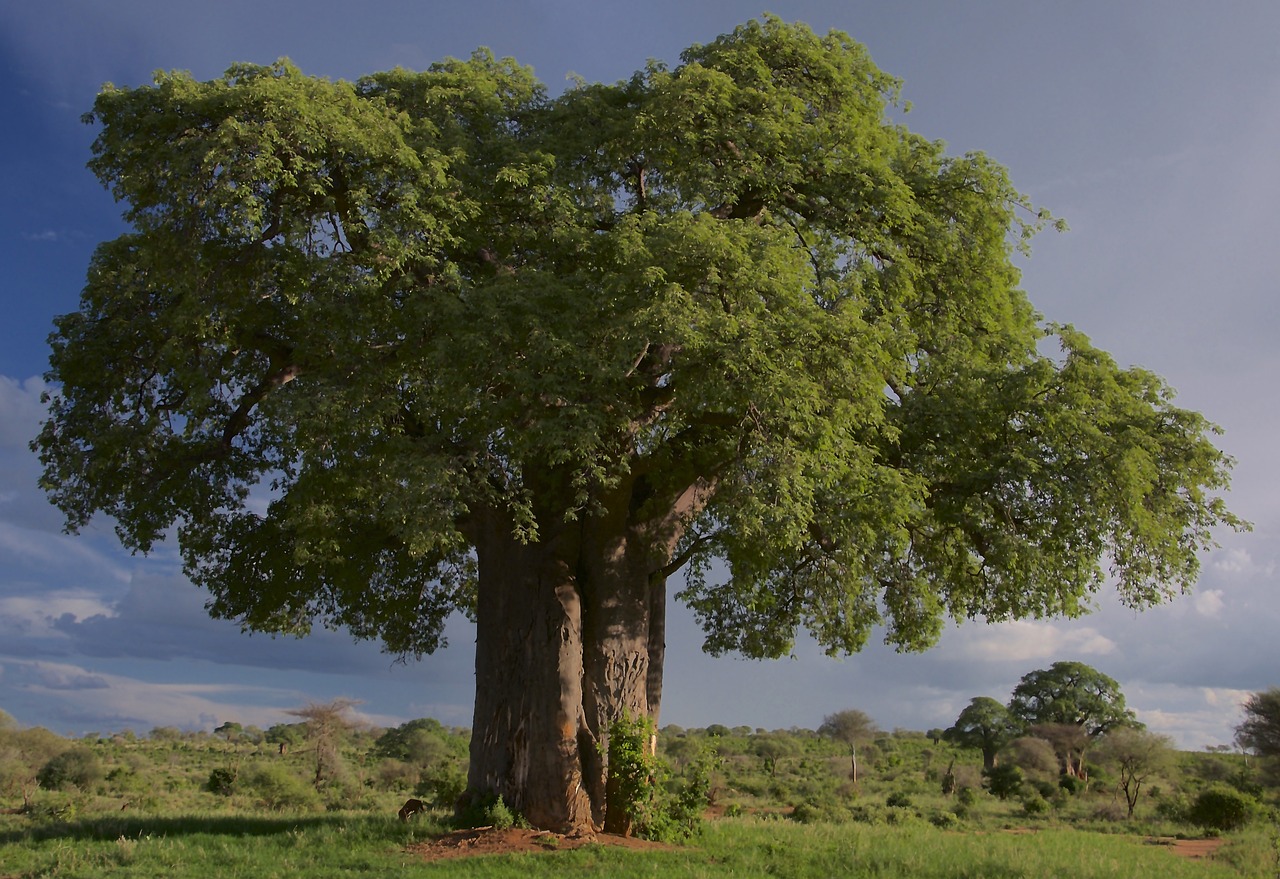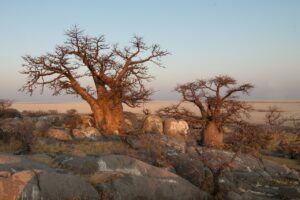Baobab
Overview
The Baobab, or Adansonia digitata, stands tall as a pillar of resilience and versatility in Africa’s arid landscapes. Famed as the “tree of life,” it serves many functions, from nourishment to medicinal. While it requires minimal watering to avoid root rot, it generously offers over 300 uses, solidifying its cultural significance3 5.

Characteristics
Known for its massive trunk, long lifespan, and ability to store large volumes of water.
Region
Baobab is typically found in Africa, including Madagascar, West Africa, South Africa, and Australia’s Kimberley region.
Natural Habitat
Baobab trees are typically found in dry, savannah regions of Africa.
Cultivation
Requires full sun, minimal watering, and well-drained soil with a neutral to slightly acidic pH.
Uses and Benefits
The Baobab tree’s bark and fruit are essential in Indigenous remedies and traditions, with over 300 life-sustaining applications3 5. This “tree of life” is not only steeped in rich cultural folklore but also offers a wide range of practical, culinary, and medicinal benefits.
Some key uses and benefits of the Baobab include:
- Providing nourishment: The fruit pulp is high in vitamin C, antioxidants, and essential minerals like potassium, magnesium, and calcium3.
- Aiding in hydration: The fruit’s pulp can be mixed with water to create a refreshing drink that helps maintain hydration in hot climates.
- Supporting digestive health: Baobab fruit pulp is a rich source of dietary fiber, which promotes digestive regularity and gut health3.
- Boosting immune function: The high vitamin C content in Baobab fruit pulp helps support a strong immune system.
- Enhancing skin health: Baobab oil, extracted from the seeds, is used in skincare products for its moisturizing and anti-aging properties.
The Baobab’s ability to flourish in arid conditions has made it a symbol of resilience and life across African communities5. Its numerous uses and benefits have earned it the well-deserved title of the “tree of life.”

Cultivation Tips
To help your Baobab tree thrive, keep these key cultivation tips in mind:
- Provide well-draining soil, preferably sandy, to mimic the Baobab’s natural arid habitat and prevent root issues.2
- Err on the side of underwatering rather than overwatering, as Baobabs are tolerant of drought but susceptible to root rot.
- Plant your Baobab in a sunny location that receives full sun exposure throughout the day.
- Don’t be surprised when your Baobab sheds its leaves; this deciduous tree loses its leaves as part of its natural seasonal cycle.1
- Be extra mindful of reducing water intake during the winter months when the tree goes dormant and requires even less moisture.2
By following these care essentials, you’ll set your Baobab tree up for long-term health and success in your garden.
Seasonal Considerations
To ensure your Baobab tree thrives, it’s essential to understand its seasonal needs. During the growing season, provide your tree with plenty of sunlight and well-draining soil. Water sparingly, as these trees are accustomed to arid conditions and can tolerate some drought.
As winter approaches, the Baobab will enter a dormant phase and shed its leaves. This is a normal part of its seasonal cycle and not a cause for concern1. During this time, reduce watering even further to prevent root issues. Overwatering, especially during dormancy, can be detrimental to the tree’s health2.
To summarize the key seasonal considerations for your Baobab tree:
- Provide full sun exposure throughout the growing season
- Plant in well-draining, sandy soil to mimic its natural habitat
- Water sparingly, erring on the side of underwatering
- Expect leaf shedding as the tree enters dormancy in winter1
- Reduce watering during the dormant phase to avoid overwatering2
By following these guidelines and respecting the Baobab’s seasonal needs, you’ll be well on your way to cultivating a healthy and resilient tree.

Issues and Troubleshooting
When cultivating the Baobab tree, one of the most common issues that may arise is root rot, which generally stems from overenthusiastic watering. As a tree that’s adapted to arid environments, the Baobab can suffer if given too much water 2.
To troubleshoot this issue, it’s crucial to mimic the Baobab’s natural dry conditions by following these steps:
- Moderate watering and only water when the soil is completely dry
- Provide well-draining soil to prevent water from pooling around the roots
- Ensure the pot or planting area has adequate drainage holes
- Allow the soil to dry out between watering sessions
By reflecting the Baobab’s native habitat and keeping it in dry conditions, you can help keep this robust tree healthy and thriving. Remember, the Baobab’s resilience in arid landscapes is a testament to its ability to flourish with minimal moisture.
History and Folklore
The Baobab tree, known as Adansonia digitata, is more than just a plant; it’s a living legend deeply woven into the tapestry of African culture. For centuries, this majestic tree has served as a symbol of life, with many traditions rooted in reverence for its life-giving properties5.
Indigenous communities have long relied on the Baobab for:
- Sustenance
- Medicine
- Materials for everyday life5
The silhouette of the Baobab against the setting sun has become an iconic image, reminiscent of an era that speaks of both endurance and harmony within the landscape it dominates. Its presence evokes a sense of timelessness and connection to the land.
The Baobab’s rich history is steeped in folklore and legend, with tales passed down through generations. These stories often revolve around the tree’s unique appearance and its ability to survive in harsh conditions, making it a symbol of resilience and strength.
References
1. Baobab Plant: Complete Guide And Care Tips – UrbanArm, https://urbanarm.com/baobab-plant/
2. How to Grow a Baobab Tree | Everything about Baobab – Balcony Garden Web, https://balconygardenweb.com/how-to-grow-a-baobab-tree-everything-about-baobab/
3. Superfruit: The Baobab – Mother Earth Gardener, https://www.motherearthgardener.com/plant-profiles/superfruit-baobab-zmaz13wzsbak/
4. Baobab | San Diego Zoo Animals & Plants, https://animals.sandiegozoo.org/animals/baobab
5. African baobab tree: how one plant creates an entire habitat, https://www.oneearth.org/species-of-the-week-african-baobab-tree/
Image Credit: 7523944
Image Credit: Darkmoon_Art
Image Credit: hbieser
Nicolas Duval
Nicolas is a passionate advocate for nature and the art of wildcrafting. His dedication shines through in Wildcraftia, a website he meticulously crafted to serve as a haven for nature enthusiasts worldwide. Driven by a deep appreciation for nature’s connection to humanity, Nicolas embarked on his journey in 2011 with SmokableHerbs, a platform showcasing his love for nature’s bounty. Building upon this foundation, he established Smokably, a thriving online store offering premium herbs and blends to a global audience.
